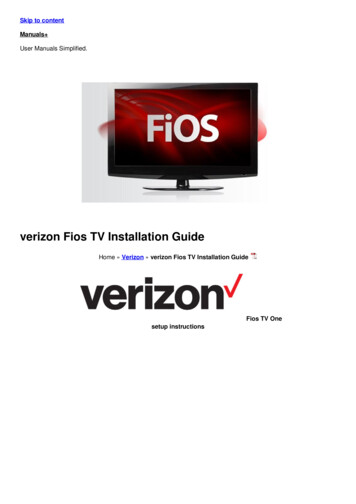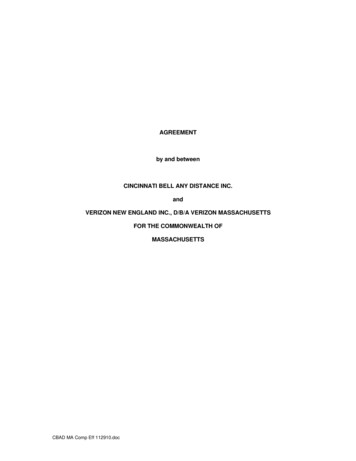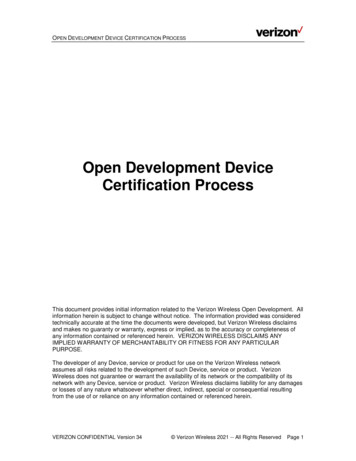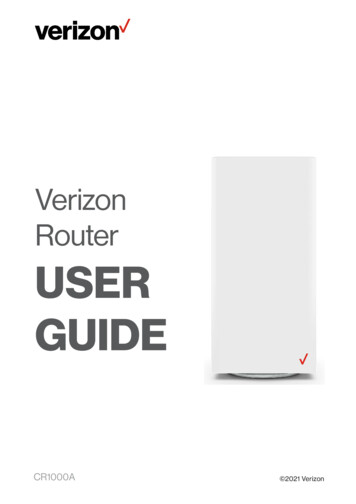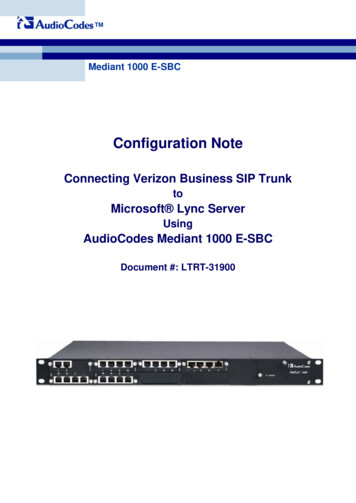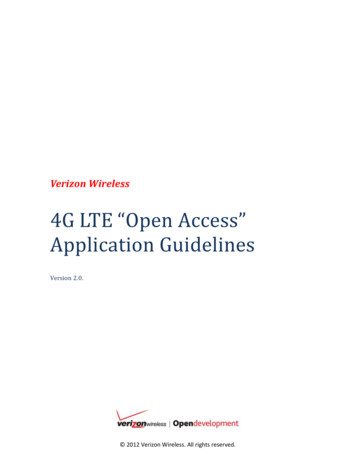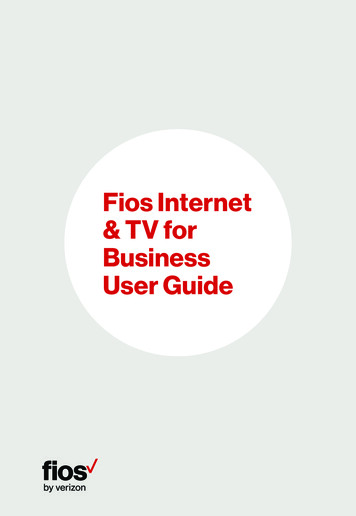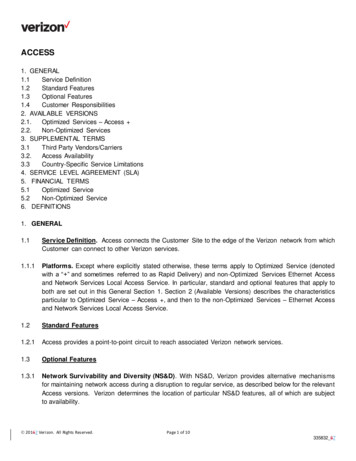
Transcription
ACCESS1. GENERAL1.1Service Definition1.2Standard Features1.3Optional Features1.4Customer Responsibilities2. AVAILABLE VERSIONS2.1.Optimized Services – Access 2.2.Non-Optimized Services3. SUPPLEMENTAL TERMS3.1Third Party Vendors/Carriers3.2.Access Availability3.3Country-Specific Service Limitations4. SERVICE LEVEL AGREEMENT (SLA)5. FINANCIAL TERMS5.1Optimized Service5.2Non-Optimized Service6. DEFINITIONS1. GENERAL1.1Service Definition. Access connects the Customer Site to the edge of the Verizon network from whichCustomer can connect to other Verizon services.1.1.1Platforms. Except where explicitly stated otherwise, these terms apply to Optimized Service (denotedwith a “ ” and sometimes referred to as Rapid Delivery) and non-Optimized Services Ethernet Accessand Network Services Local Access Service. In particular, standard and optional features that apply toboth are set out in this General Section 1. Section 2 (Available Versions) describes the characteristicsparticular to Optimized Service – Access , and then to the non-Optimized Services – Ethernet Accessand Network Services Local Access Service.1.2Standard Features1.2.1Access provides a point-to-point circuit to reach associated Verizon network services.1.3Optional Features1.3.1Network Survivability and Diversity (NS&D). With NS&D, Verizon provides alternative mechanismsfor maintaining network access during a disruption to regular service, as described below for the relevantAccess versions. Verizon determines the location of particular NS&D features, all of which are subjectto availability. 20167 Verizon. All Rights Reserved.Page 1 of 10335832 67
1.3.2Proactive Notification (Optimized Services Only). Where Customer receives Proactive Notification fora network service, it will also apply to the Access connected to that network service. Proactive Notificationis described in Customer’s applicable network Service Attachment.1.4Customer Responsibilities1.4.1Installation. Unless otherwise provided by Verizon under a separate Service Attachment, Customer willprovide the following to support installation activities such as site surveys, testing and activation: Space and power for Verizon terminating equipment if required to deliver service. All facilities and internal cabling to connect Customer’s Site to the Demarcation of the Access circuit. Notice to Verizon of the existence and location of wiring or any other risk factors on the Customer’sSite which may affect Verizon’s installation of the Access circuit.2. AVAILABLE VERSIONS2.1Optimized Services – Access 2.1.1Standard Service Features2.1.1.1Access Speed. Verizon provides capacity throughput based on the Access Speed selected by theCustomer, which is the maximum possible speed.2.1.1.2Performance Grades. Verizon provides operational performance (e.g., mean time to repair andavailability) and application performance (e.g., data delivery ratio) at the performance grade (e.g.,Platinum, Gold, Silver, Bronze) selected by the Customer.2.1.1.3Handoff. Verizon hands off Access service based on Customer’s equipment (e.g., Ethernet, TDM,Wireless), which include the following characteristics: For Ethernet, Verizon provides a User Network Interface (UNI) that allows Customer to terminateone or more Ethernet virtual connections (“EVC’s”) onto a single Ethernet Access UNI). For Time Division Multiplexing (“TDM”), Verizon’s handoff may include an Access connection overa Dense Wave Division Multiplexing network. For Wireless Connection (Outside the US), Verizon provides Access via a wireless connection(used as primary or backup access) into Customer’s Verizon-provided services.2.1.1.4UNI Speed. For an Ethernet handoff from Customer Equipment, Verizon provides the UNI at thespeed ordered by Customer.2.1.1.5Demarcation Interface Options.options.2.1.2Verizon provides electrical and optical demarcation interfaceOptional Service Features 20167 Verizon. All Rights Reserved.Page 2 of 10335832 67
2.1.2.1Express Connect. With Express Connect, Verizon provides access to supported Verizon networkservices through a wireless connection until the wired service is activated except for customersoutside the U.S. who requested a wireless connection only. At the time wired service is activated,this wireless connection is converted to wireless backup service. Details on supported Verizonnetwork services is available from Verizon on request.2.1.2.2Wireless Backup. With Wireless Backup, Verizon provides wireless backup for Customer InternetDedicated or Broadband service, or connectivity for a remote location into a Verizon-provided networkservice.2.1.2.3Network Survivability &Diversity. The following NS&D options are available: Layer 2 Aggregation Geographic Diversity. With Layer 2 Aggregation Geographic Diversity,Verizon provides two circuits in a mated pair relationship between the Customer Site and theService Edge of the provisioned circuits. The Layer 2 aggregation devices on the first circuit willbe located in different buildings and/or survivable from the Layer 2 aggregation devices on theasecond Customer circuit connected to a different initial Verizon Layer 2 aggregation device(determined by Verizon) in a different building from the primary circuit. Customer Premises Diversity (U.S. Only). With Customer Premises Diversity, Verizon willdeliver Access via either a 2 or 4 wire facility, rather than a single wire facility. Carrier Diversity. Where Verizon provides the primary Access circuit, and Customer ordersCarrier Diversity, Verizon will obtain an additional access circuit from an alternate access provider,where available. Carrier Diversity does not provide path diversity nor ensure full geographicdiversity. Preferred Carrier Designation. With the Preferred Carrier Designation feature, Verizon willobtain the access circuit from an access provider selected by Customer from available carriers.The Preferred Carrier Designation feature does not provide path diversity nor ensure fullgeographic diversity.2.1.2.4Customer-Provided Carrier Facility Assignment (CFA) (U.S. Only). Upon Customer request,Verizon will deliver Access to the designated meet-me point on the Customer’s private Verizon orILEC dedicated rings, hubs and channelized facilities.2.1.2.5Customer-Provided Access. With the Customer-Provided Access feature, where Customer has athird-party local access circuit (subject to an interconnection arrangement with Verizon) at a Verizon approved location, Verizon will connect that local access circuit to its related Verizon networkservice(s).2.1.2.6Customer Provided UNI (U.S. Only). Where Customer has a qualifying Verizon ILEC UNI (e.g., foran existing Ethernet service), Verizon will deliver Access to that UNI. Details on qualifying UNIs areavailable on request.2.1.3Customer Responsibilities 20167 Verizon. All Rights Reserved.Page 3 of 10335832 67
2.1.3.1Customer Provided Carrier Facility Assignment. Where Access is provided to a Customerprovided Carrier Facility Assignment (CFA), Customer will provide a letter of authorization (LOA)when the terminating facilities are not provided by Verizon as part of Access, including when theterminating facilities are provided by a Verizon ILEC. Customer will ensure there is adequate capacityon the facility when providing CFA.2.1.3.2Customer-Provided UNI. Customers providing the UNI between Verizon’s Access service and theCustomer’s equipment will obtain an LOA authorizing Verizon to order an Ethernet virtual connectionto the Customer-provided UNI. Customer will ensure there is adequate capacity on the UNI.2.1.3.3Abuse or Fraudulent Use of SIM Cards. Customer will use SIM cards provisioned by Verizon inconnection with Access service only to use that service. Any other use is a material breach of theAgreement.2.1.3.4Quality of Signal. Customer will check the quality of the signal at the location where the Access witha wireless connection will be installed prior to ordering the service. Wireless network coverage andother factors may affect the availability and performance of the service.2.2Non-Optimized Services (U.S. Only)2.2.1General2.2.1.1Versions of Non-Optimized Services. Ethernet Access Network Services Local Access Services (TDM Access – US Interstate and International)- Analog Access- DS0 or E0 Access- T1 or E1 Digital Access- DS3 or E3 Access- SONET or STM Access- Enterprise Digital Subscriber Line2.2.1.2Network Configurations. Ethernet Access and Network Services Local Access are ordered basedon Customer’s network configuration (see types below). Configuration types reflect the performancecharacteristics and carrier facilities used to provide service. Verizon network optimization and otherupdates may result in a change in the network configuration used to provide service to Customer butCustomer’s performance characteristics will remain the same or better. 20167 Verizon. All Rights Reserved.Page 4 of 10335832 67
TypePerformance Characteristics1*On-Net Premium2 (U.S. Only)Off-Net Premium3*Off-Net Premium4Off-Net Premium5 (Outside U.S. Only) Off-Net PremiumEA StandardOff-Net Standard*Network Services Local Access is only available on Type 1 and Type 3.2.2.1.32.2.2Optional Service Feature - Customer-Provided Access. With the Customer-Provided Accessfeature available for Network Services Local Access, where Customer has a third-party local accesscircuit (subject to an interconnection arrangement with Verizon) at a Verizon-approved location,Verizon will connect that local access circuit to its related Verizon network service(s).Ethernet Access2.2.2.1Service Definition. With Ethernet Access, Verizon provides Access with the speed and flexibilityenabled by Ethernet technology.2.2.2.2Standard Service Features. Ethernet Access allows Customer to terminate single and/or multipleEthernet Virtual Circuits (EVCs) from Customer equipment onto a single Ethernet Access UNI.2.2.2.3Optional Service Features (NS&D) Layer 2 Switch Geographic Diversity. With Layer 2 Switch Geographic Diversity,Verizon provides a second Customer circuit connected to a different Verizon Layer 2 switchdevice (determined by Verizon) in a different building from the primary circuit. (NS&D) UNI Device Diversity (U.S. Only). Where Customer orders UNI Device Diversity at thesame time as the primary Type 1 or Type 3 Access circuit, Verizon provides a second Customercircuit via a unique Network Interface Device (NID) at the same customer premises. (NS&D) UNI Card Diversity (U.S. Only). Where Customer orders UNI Card Diversity at the sametime as the primary Ethernet Access circuit, Verizon provides a second circuit via a uniquecustomer-facing card on the Network Interface Device (NID) at the same customer premises. (NS&D) UNI Port Protection. With UNI Port Protection for Type 1, and Type 3 on FET and GBEinterfaces, Verizon provides an additional interface port connection at Customer’s designatedpremises.2.2.3Network Services Local Access – Analog Access (U.S. Only)2.2.3.1Service Definition. With Analog Access, Verizon provides Access with the characteristics enabledby analog technology.2.2.3.2Standard Service Features. With Analog Access, Verizon provides a 56/64kbps Access circuit thatprovides voice frequency transmission capability in the nominal frequency range of 300 to 3000 Hz. 20167 Verizon. All Rights Reserved.Page 5 of 10335832 67
2.2.3.32.2.42.2.4.12.2.5Optional Service Features Signaling. With Signaling, Verizon provides the capability for one Customer premises to alertanother Customer premises of the same service with which it wishes to communicate. Data Conditioning. With Data Conditioning, Verizon provides transmission characteristics forVoice Grade Services, such as controlling attenuation distortion and envelope delay distortion. Access Integration Option. With the Access Integration Option, Verizon enables Customers toutilize their dedicated Access lines to carry traffic for both an inbound and an outbound serviceover the same circuits.Network Services Local Access – DS0 and E0 Access.Service Definition. With DS0 and E0 Access, Verizon provides a digital Access circuit up to 64kbps.Network Services Local Access – T1 or E1 Digital Access2.2.5.1Service Definition. With T1 or E1 Digital Access, Verizon provides a high capacity digital localAccess arrangement, with 24 channels and up to 1.544 Mbps for the T1 and 2.048Mbps for E1.2.2.5.2Optional Features Integrated Services Digital Network (“ISDN”) Service . With ISDN, Verizontransports voice, data, and video communications services on a single circuit via standard interfaces. Access Integration Option. With the Access Integration Option Verizon enables Customers toutilize their dedicated Access lines to carry traffic for both an inbound and an outbound serviceover the same circuits. Primary Rate Interface (“PRI”). With PRI, Verizon will transport traffic from MCI 800 Service andVnet, and MCI 800 Service and MCI Vision on a single circuit. An attribute of PRI, Call-by-CallService Configuration, allows for these services to share dynamically allocated individual circuitswithin the PRI. The PRI consists of a 64 kbps D channel and 23 B channels of 64 kbps each. Thebearer, or B, channels are used to access Verizon services supported over the PRI. The Dchannels are used to carry signaling and control information for the associated B channels. Call-by-Call Service Configuration. With Call-by-Call Service Configuration, Verizon willtransport traffic across the B channels within a PRI for multiple subscribed services. Call-by-CallService Configuration can be used in the following combinations: Vnet /MCI 800 Service and MCIPrism 1/MCI 800 Service.2.2.6Network Services Local Access – DS3 or E3 Local Access. DS3 and E3 Local Access provides ahigh capacity digital local Access arrangement that consists of an Access circuit ) that relies on DS3 orE3 transmission technology.2.2.7Network Services Local Access – SONET or STM Access. With SONET (Synchronous OpticalNetworking), Verizon uses a protocol designed to transfer digital data over fiber optic channels to providea high capacity digital local Access arrangement with OC3/STM-1 and above access. 20167 Verizon. All Rights Reserved.Page 6 of 10335832 67
2.2.8Enterprise Digital Subscriber Line (eDSL). With eDSL, Verizon provides a capability to originate andterminate high-speed digital data over twisted-pair copper wire connections at speeds ranging between128 kbps and 1.024 Mbps. eDSL is no longer available for new installations.3.SUPPLEMENTAL TERMS3.1Third Party Vendors/Carriers. When the Access circuit is procured from a third party carrier, and thethird party carrier requires certain forms to be signed to process Customer’s order (e.g., Warranties ofAgency, Letters of Agency, Right of Entry forms, service terms, etc.), Customer will sign such formspromptly in order to procure the Access in a timely manner.3.2Access Availability. The actual availability of Access cannot be determined definitively until the date ofinstallation. If Customer-ordered Access is determined to be unavailable, Verizon will notify Customerpromptly, cancel the unavailable order, and upon Customer request, requote the Access based on thelatest availability information. There will be instances where a circuit is quoted, using the informationavailable at the time of a quote, but at the time the order is placed or upon installation, the Access isdeemed not available and other Access, sometimes with higher charges may be required and in suchinstances the circuit is requoted to Customer.3.2.1Diversity Availability. Diversity which involves a third party Access provider will be provided only atCustomer Sites where such diversity is available and provided by the relevant access provider asselected by Verizon. In the event that Verizon becomes aware of a third party provided Access servicefailure or outage which impacts the diversity of circuits, Verizon will use commercially reasonable effortsto work with the third party Access provider to restore the diversity as soon as reasonably possible.3.3Country-Specific Service Limitations3.3.1Permitted Use. For Access provided outside Hawaii and the U.S. Mainland or within Alaska, Customerwill use Access circuits only in conjunction with a Verizon-provided network service. If Customer violatesthis use requirement, Verizon may terminate the Access circuit or take other appropriate action to meetits legal and regulatory obligations.3.3.2United States – Interstate Service Only. Access in the US Mainland is offered only on a jurisdictionallyinterstate basis. With respect to its use of Access, Customer agrees that more than 10 percent) ofCustomer’s per-circuit traffic crosses state line boundaries (which is commonly referred to as 10 PIU –Percent Interstate Usage).3.3.3Vietnam Responsibility Contract. Where Customer subscribes for Access in Vietnam through Verizon,Customer shall be required to enter into a Responsibility Contract (or other similar agreements) with theAccess service provider. Customer is hereby notified that Verizon is not permitted to modify the terms ofthe Responsibility Contract and is not allowed to enter into that contract on Customer’s behalf.4.SERVICE LEVEL AGREMENT (SLA). There is no separate Service Level Agreement for Access.Access is included in the SLA for the network service to which it is connected (e.g. Private IP, InternetDedicated, etc.). 20167 Verizon. All Rights Reserved.Page 7 of 10335832 67
5.FINANCIAL TERMS5.1Optimized Service. Customer will pay the charges for Optimized Access specified in the Agreement,including those below. Charges below are in U.S. dollars and will be billed in the invoice currency forthe associated service. In the U.S., the charges for Optimized Access are at the following ice guide/reg/cp access plus access pricing toc.htm5.1.1Administrative Charges.Administrative ChargeCharge InstanceNRCAdministrative ChangeCancellation of OrderExpedite in the United StatesExpedite in Canada and FranceExpedite in other countriesAfter Hours InstallationPending Order ChangePhysical ChangeService Date ChangeBandwidth ReconfigurationPerPerPerPerPerPerPerPerPerPer 60 800 1,400 6,000 3,000 600 200 200 100 tCircuitCircuitCircuit5.1.2Off Net Special Build. Where Verizon uses third-party network(s) to provide Access, and a third partyneeds to extend its network to reach the Customer Site, Verizon will arrange for the third party to performsuch work. Customer will pay the cost of that third-party work, which will be added to Customer’s ServiceOrder and which will extend the installation period.5.1.3Special Construction. If, after an order is placed, Verizon finds that third-party special constructionservices are needed to build, configure or install any additional facilities and/or equipment necessary forVerizon to provide Access service, Verizon will notify the Customer of any such special constructioncharges. If Customer does not accept the special construction charges, Customer may terminate theorder(s) affected by the special construction charges, with no cancellation fee(s).5.1.4Wireless Connections. Monthly data plan charges for wireless connections are billed in advance.Overage usage (usage in excess of the monthly data plan amount) will be rounded to the next full GB oftraffic and will be billed in arrears. Data usage not used in a particular monthly billing period may not becarried forward to another month the data plan selected by Customer. With regard to Wireless UNI,Customer charges are based on data usage sent through the wireless connection (including resent data),not data usage received by Customer Equipment.5.1.4.1 Wireless Connection - Upgrades. With respect to Customer-requested upgrades to its data plan forAccess with Wireless UNI, the MRC will be prorated according to the date the new data plan is available 20167 Verizon. All Rights Reserved.Page 8 of 10335832 67
to Customer. Overage usage will be based on the data plan in effect on the last day of the billing periodwhen traffic usage is calculated. The billing period with respect to overage usage may differ accordingto the country where Access with Wireless UNI is provisioned.5.1.5Express Connect – US Only. Customer will pay Verizon’s standard MRC for Wireless UNI plus an NRCthat covers all of Customer’s usage while Wireless UNI is being used as Express Connect.5.1.6Express Connect - Outside the US. Customer will pay Verizon’s standard MRC for the data planselected for the Wireless Connection and the Overage usage charges, as applicable.5.1.7Carrier Facilities Assignment (CFA). The MRC and NRC for Carrier Facilities Assignment are inclusiveof Verizon charges and include port/rider/appearance charges only when the facility provider chargesVerizon back for these charges. Where the facility provider charges Customer directly forport/rider/appearance charges, Customer is responsible for paying for such charges directly to theprovider, and Verizon’s invoices to Customer will not include such charges. Customer must provide thefollowing information: Meet Me location and ring/hub/parent provider name. If a Verizon (non-VerizonILEC) Ring, Customer must also provide the Verizon ring/hub status, and Verizon ring/hub type. IfCustomer provides incorrect information, the CFA may need to be re-quoted.5.1.8Charges for Customer-Provided Access. Where Customer provides its own local access service, anAccess MRC and NRC (cross-connect charge) will still apply to cover Verizon’s provision of a physicalconnection from that access service to the Service Equipment used to provide the associated Verizonnetwork service. If incorrect information is provided by Customer, the cross-connect will need to be requoted.5.1.9When Local Access with Wireless Connection provided in the U.S. is used with Verizon’s InternetDedicated Service, such connection is subject to the following Wireless Regulatory Surcharge: 0.02per connection per month.5.1.10Access Speed Changes. Speed changes on an existing Access circuit are only supported byVerizon in specific limited circumstances. Otherwise, where alternative Access speeds are availablefrom Verizon, Customer must present a new order to Verizon to obtain such alternative speeds andsimultaneously terminate its existing Access service, for which it will pay early termination charges ifapplicable. Customer will be responsible for any third party charges incurred by Verizon in order toimplement any requested Access speed changes or any termination. The applicable NRC and MRCassociated with the new Access circuit speed will be effective from the day the changed Accessbandwidth is available to Customer.5.1.11Access Moves. Customer-requested moves of Access to a new location will be quoted on anindividual case basis and, as with speed changes, may require the termination of Customer’s existingAccess circuit and installation of a new one. For Customer-requested moves of Access to a newlocation, Customer will pay early termination charges as applicable and any third party chargesincurred by Verizon in order to implement the move. The newly-contracted Access will include theapplicable NRC and MRC associated with the new Access circuit. 20167 Verizon. All Rights Reserved.Page 9 of 10335832 67
5.1.12NS&D Features. Customer must order and pay for the two access circuits from Verizon to configureLayer 2 Aggregation Geographic Diversity and Carrier Diversity, plus an additional charge for theDiversity Feature itself, as applicable. With Preferred Carrier Designation Diversity, Customer mustorder and pay for the access circuit, plus an additional charge for the Diversity Feature itself, asapplicable.5.2Non-Optimized Service. Customer will pay MRCs and NRCs for non-Optimized Access Service asspecified in the Agreement. The online pricing for Access provided by a U.S. entity is e guide/reg/cp access network services local access.htm.5.2.1Commitment Period. Customer will pay the applicable circuit MRC for any Network Services LocalAccess Service circuit of DS3 or larger or for any Ethernet Access for a minimum of 12 months, whichCustomer will pay even if the circuit is cancelled sooner (unless cancelled by Customer for Cause, asdefined in Customer’s Agreement).5.2.2Special Construction. If, after an order is placed, Verizon finds that third-party special constructionservices are needed to build, configure or install any additional facilities and/or equipment necessary forVerizon to provide Access service, Verizon will notify the Customer of any such special constructio ncharges. If Customer does not accept the special construction charges, Customer may terminate theorder(s) affected by the special construction charges, with no cancellation fee(s).6.DEFINITIONS. The following definitions apply to Access, in addition to those identified in the MasterTerms.DemarcationMeet Me LocationTimeDivisionMultiplexing (TDM) 20167 Verizon. All Rights Reserved.The point where the access circuit is delivered. For jointlyused office buildings, it is often a common entrance point fortelecommunication providers, which may not be theCustomer’s physical location.If the customer has a dedicated ring, the Meet Me Location isthe node on the ring where customer will provide CarrierFacility Assignment (CFA). For customer provided access,the Meet Me Location is the edge of the Verizon networkwhere the customer is bringing their access (usually a PatchPanel on which the Customer’s vendor resides).A technique for transmitting two or more signals over thesame telephone line, radio channel, or other medium. Eachsignal is sent as a series of pulses or packets, which areinterleaved with those of the other signal or signals andtransmitted as a continuous stream.Page 10 of 10335832 67
For Wireless Connection (Outside the US), Verizon provides Access via a wireless connection (used as primary or backup access) into Customer's Verizon-provided services. 2.1.1.4 UNI Speed. For an Ethernet handoff from Customer Equipment, Verizon provides the UNI at the speed ordered by Customer. 2.1.1.5 Demarcation Interface Options.
